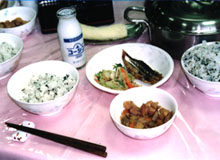BACK TO SCHOOL:
Grown-Ups' Nostalgia Puts School Food Back on Menu
November 8, 2000
|
 |
|
A typical school lunch today includes such dishes as pickled plum rice and fried fish.
|
It is standard practice in Japanese public elementary and middle schools for students to eat lunches prepared by the school in their classrooms every weekday. This system is called kyushoku (school lunch). School lunches, or more accurately kyushoku-style meals, are proving increasingly popular in fast-food restaurants, taverns, and other eateries. This trend is not due to the tastiness of school-style fare; rather, according to one tavern owner, "Eating these meals with friends takes people back to their elementary and middle school days and gives them the chance to talk about memories of those times."
Noodle Nostalgia
Some schools in Europe and the United States also prepare lunches for their students, but these are usually served in a cafeteria. This is a big difference from Japanese school lunches. Kyushoku began in the 1890s--when Japan as a whole was still poor--and gradually spread. Schools did not have enough money to build cafeterias. The "tradition" of eating in classrooms is alive today, and although many schools have well-equipped kitchen facilities, lunches are still eaten mainly in classrooms.
Gakko ni Iko! (Let's Go to School!), a tavern in Shizuoka Prefecture, features desks, chairs, floorboards, and a blackboard that were actually used in an elementary school, giving the interior an authentic school-like feel. The tavern does, of course, serve alcohol. With a glass in one hand, the customers, who are naturally all former elementary and middle schoolers, tuck into the school-style food while eagerly chatting about their school days.
The tavern's most popular set dish is soft udon noodles with either curry or meat sauce, which costs 400 yen (3.60 U.S. dollars at 110 yen to the dollar). These soft noodles are ready-boiled and come in a sealed bag. They are eaten by tearing the bag open, emptying the noodles onto the plate, and pouring over the curry or meat sauce. It is a dish that used to be popular in schools, and one 25-year-old woman admits, "When I see that soft-noodle set on the same kind of plates and with the same kind of cutlery I used in school, it makes my heart pound with excitement."
Taverns like this one that offer kyushoku-style dishes are proving popular as venues for class reunions.
No Takers for School Milk
In June 2000 the Harajuku branch of the Kyushoku Toban (School Lunch Rota) fast-food restaurant opened in the fashionable Tokyo district of Harajuku, which is the source of much of Japan's youth culture. To remind customers of the way students in charge of serving school lunches used to dress, the waitresses at this eatery wear aprons. The food on offer includes many childhood favorites, such as fried koppepan (spindle-shaped bread) covered with soybean flour or cocoa powder and "Milmake," a powdered drink mix that is added to milk and comes in various flavors, including strawberry and coffee.
School lunches in Japan have a long history and have changed with the times. In 1947, just after the end of World War II, food was extremely scarce. School lunches at this time often consisted of little else than milk, and not even fresh milk but skimmed milk powder provided as part of aid by UNICEF, then known as the United Nations International Children's Emergency Fund. The powder was mixed with hot water to make the milk. Even the underfed children of the time thought the milk tasted terrible, however. The tavern Gakko ni Iko! tried offering a flavor-enhanced version of this milk to customers, but it seems childhood memories of the milk die hard; almost without exception they declined the offer.
Back to Main Index
 Copyright (c) 2000 Japan Information Network. Edited by Japan Echo Inc. based on domestic Japanese news sources. Articles presented here are offered for reference purposes and do not necessarily represent the policy or views of the Japanese Government. Copyright (c) 2000 Japan Information Network. Edited by Japan Echo Inc. based on domestic Japanese news sources. Articles presented here are offered for reference purposes and do not necessarily represent the policy or views of the Japanese Government.
|



















